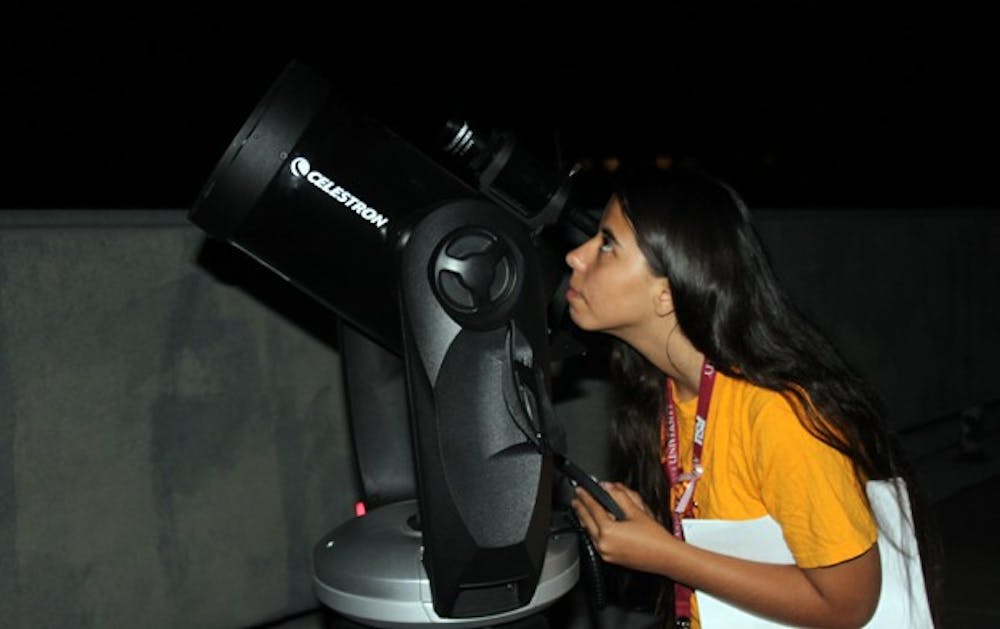
A six-foot-tall person looks through a half-inch hole to see an infinite universe. It’s not just math, nor is it just science -- it’s the ASU Astronomy Club’s goal to reach everyone interested in worlds beyond our own.
“You have people make a connection to something they’ve never seen before,” says Ray Sanders, the ASU Astronomy Club outreach director.
ASU has never had an astronomy club, Sanders says, after having asked numerous professors. For the past half-century the ASU geology club, GeoClub, incorporated astronomy into its areas of interest, he says, but now the group has become its own separate entity.
Pye Pye Zaw, one of four executive board members for the astronomy club and an earth and space exploration junior says the astronomy club, also known as the Astro Devils, arose in part from Astronomy Open House, a monthly night of telescope viewings at the observation deck on the roof of the Bateman Physical Sciences Building.
But Astronomy Open House was only a monthly event run mainly by graduate students, with some help from the ASU GeoClub, Zaw says.
After, “a lot of inquiries about an astronomy club,” Zaw says one of the graduate students, Kimberley Ward-Duong, sent out an email to undergraduate students in the School of Earth and Space Exploration about starting an astronomy club.
Ward-Duong, a first-year Ph.D candidate in astrophysics, says she was shocked ASU most likely never had an astronomy club. Ward-Duong says she checked with several professors and knows for certain no club has existed for at least 20 years.
“We [graduate students] were really surprised there wasn’t already an astronomy club at ASU, especially because Arizona has such a thriving amateur astronomy community,” Ward-Duong says.
Ward-Duong, who attended NAU for her undergraduate degree in astronomy, mathematics and physics, says NAU has had an astronomy club at least since the '70s.
University of Arizona Astronomy Club President Kevin Hardegree-Ullman says UA’s club has been around at least since the mid-'90s.
A few preliminary meetings later, a board was formed and by October 2011 ASU had its first astronomy club, dubbed the ASU Astro Devils.
While 42 people attended the first meeting, Zaw and Sanders say they estimate about 20 active members, with the number fluctuating on a weekly basis.
Sanders, an earth and space exploration senior with an emphasis in astrophysics, says he wants the astronomy club to be open to all students and majors for them to discover and appreciate the night sky.
“It’s one thing to look at something in a book, but it’s another thing to see it with your actual eyes and you kind of almost build a connection with it,” Sanders says.
The club wants to take some of the members’ telescopes, set them up along or near Tempe Town Lake and offer passersby to view the sky in a completely different way, Sanders says.
Zaw says the Astro Devils plan to teach members about how to use a telescope.
“There isn’t really a club that teaches you how to use a telescope, teaches you about stars in the sky,” Zaw says.
Eventually, the club would like to raise money and either buy its own telescopes or save university telescopes in disrepair.
The club would also like to raise awareness about light pollution and get children interested in science, Sanders says.
“One of the big problems in this country is the anti-science mentality. There’s a lot of people that fear science,” Sanders says.
By hosting an open discussion about science with people of all backgrounds and experiences, Sanders says he thinks science will benefit.
TJ Slezak, another executive board member of the club and an earth and science exploration major with an emphasis in geological sciences, says, “The more people we can get interested in it, the more it will help the subject grow.”
Reach the reporter at hhuskins@asu.edu




